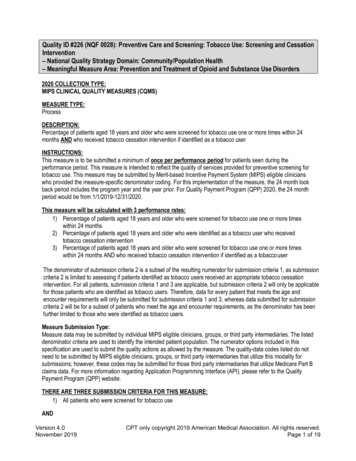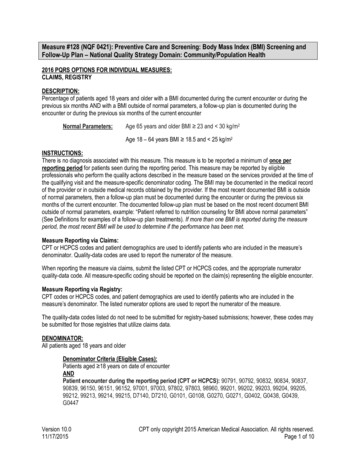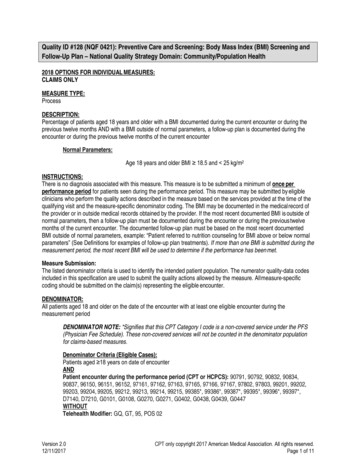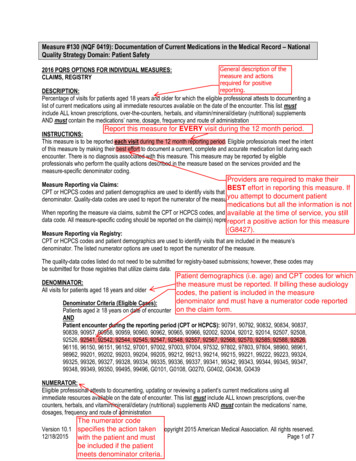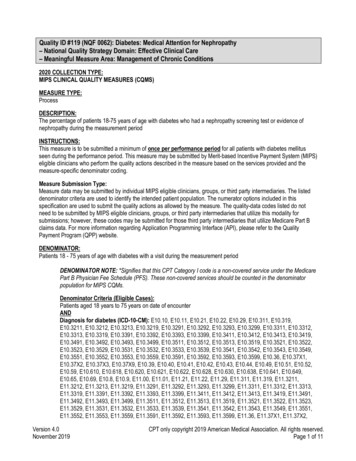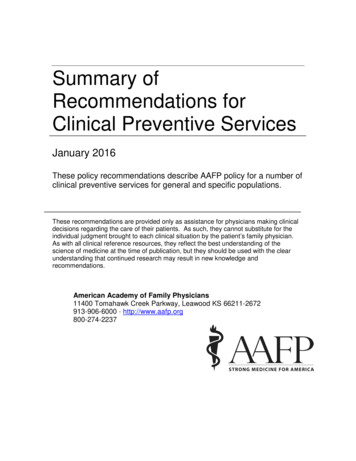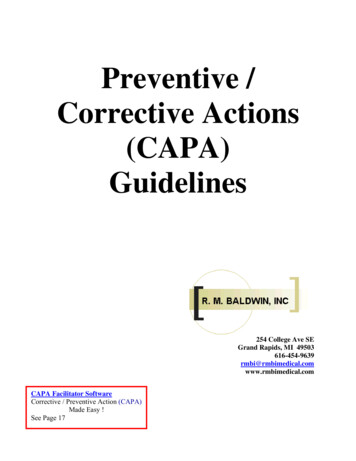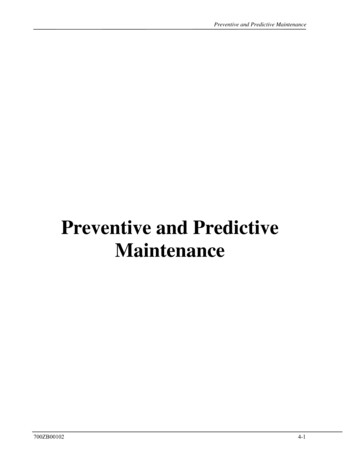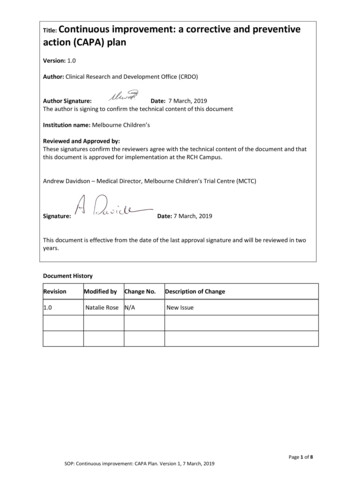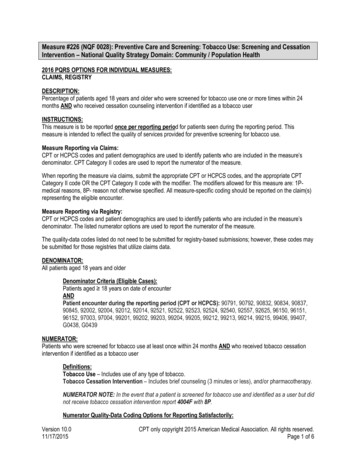
Transcription
Measure #226 (NQF 0028): Preventive Care and Screening: Tobacco Use: Screening and CessationIntervention – National Quality Strategy Domain: Community / Population Health2016 PQRS OPTIONS FOR INDIVIDUAL MEASURES:CLAIMS, REGISTRYDESCRIPTION:Percentage of patients aged 18 years and older who were screened for tobacco use one or more times within 24months AND who received cessation counseling intervention if identified as a tobacco userINSTRUCTIONS:This measure is to be reported once per reporting period for patients seen during the reporting period. Thismeasure is intended to reflect the quality of services provided for preventive screening for tobacco use.Measure Reporting via Claims:CPT or HCPCS codes and patient demographics are used to identify patients who are included in the measure’sdenominator. CPT Category II codes are used to report the numerator of the measure.When reporting the measure via claims, submit the appropriate CPT or HCPCS codes, and the appropriate CPTCategory II code OR the CPT Category II code with the modifier. The modifiers allowed for this measure are: 1Pmedical reasons, 8P- reason not otherwise specified. All measure-specific coding should be reported on the claim(s)representing the eligible encounter.Measure Reporting via Registry:CPT or HCPCS codes and patient demographics are used to identify patients who are included in the measure’sdenominator. The listed numerator options are used to report the numerator of the measure.The quality-data codes listed do not need to be submitted for registry-based submissions; however, these codes maybe submitted for those registries that utilize claims data.DENOMINATOR:All patients aged 18 years and olderDenominator Criteria (Eligible Cases):Patients aged 18 years on date of encounterANDPatient encounter during the reporting period (CPT or HCPCS): 90791, 90792, 90832, 90834, 90837,90845, 92002, 92004, 92012, 92014, 92521, 92522, 92523, 92524, 92540, 92557, 92625, 96150, 96151,96152, 97003, 97004, 99201, 99202, 99203, 99204, 99205, 99212, 99213, 99214, 99215, 99406, 99407,G0438, G0439NUMERATOR:Patients who were screened for tobacco use at least once within 24 months AND who received tobacco cessationintervention if identified as a tobacco userDefinitions:Tobacco Use – Includes use of any type of tobacco.Tobacco Cessation Intervention – Includes brief counseling (3 minutes or less), and/or pharmacotherapy.NUMERATOR NOTE: In the event that a patient is screened for tobacco use and identified as a user but didnot receive tobacco cessation intervention report 4004F with 8P.Numerator Quality-Data Coding Options for Reporting Satisfactorily:Version 10.011/17/2015CPT only copyright 2015 American Medical Association. All rights reserved.Page 1 of 6
Patient Screened for Tobacco Use, Identified as a User and Received InterventionPerformance Met: CPT II 4004F:Patient screened for tobacco use AND received tobaccocessation intervention (counseling, pharmacotherapy, orboth), if identified as a tobacco userORPatient Screened for Tobacco Use and Identified as a Non-User of TobaccoPerformance Met: CPT II 1036F:Current tobacco non-userORORTobacco Screening not Performed for Medical ReasonsAppend a modifier (1P) to CPT Category II code 4004F to report documented circumstances thatappropriately exclude patients from the denominatorMedical Performance Exclusion: 4004F with 1P: Documentation of medical reason(s) for not screeningfor tobacco use (eg, limited life expectancy, othermedical reasons)Tobacco Screening OR Tobacco Cessation Intervention not Performed, Reason Not OtherwiseSpecifiedAppend a reporting modifier (8P) to CPT Category II code 4004F to report circumstances when the actiondescribed in the numerator is not performed and the reason is not otherwise specified.Performance Not Met: 4004F with 8P:Tobacco screening OR tobacco cessation interventionnot performed, reason not otherwise specifiedRATIONALE:This measure is intended to promote adult tobacco screening and tobacco cessation interventions for those who usetobacco products. There is good evidence that tobacco screening and brief cessation intervention (includingcounseling and/or pharmacotherapy) is successful in helping tobacco users quit. Tobacco users who are able to stopsmoking lower their risk for heart disease, lung disease, and stroke.CLINICAL RECOMMENDATION STATEMENTS:The following evidence statements are quoted verbatim from the referenced clinical guidelines:All patients should be asked if they use tobacco and should have their tobacco use status documented on a regularbasis. Evidence has shown that clinic screening systems, such as expanding the vital signs to include tobacco usestatus or the use of other reminder systems such as chart stickers or computer prompts, significantly increase ratesof clinician intervention. (Strength of Evidence A) (U.S. Department of Health and Human Services. Public HealthService, 2008)All physicians should strongly advise every patient who smokes to quit because evidence shows that physicianadvice to quit smoking increases abstinence rates. (Strength of Evidence A) (U.S. Department of Health andHuman Services. Public Health Service, 2008)Minimal interventions lasting less than 3 minutes increase overall tobacco abstinence rates. Every tobacco usershould be offered at least a minimal intervention, whether or not he or she is referred to an intensive intervention.(Strength of Evidence A) (U.S. Department of Health and Human Services. Public Health Service, 2008)The combination of counseling and medication is more effective for smoking cessation than either medication orcounseling alone. Therefore, whenever feasible and appropriate, both counseling and medication should be providedto patients trying to quit smoking. (Strength of Evidence A) (U.S. Department of Health and Human Services. PublicHealth Service, 2008)Clinicians should encourage all patients attempting to quit to use effective medications for tobacco dependencetreatment, except where contraindicated or for specific populations for which there is insufficient evidence ofVersion 10.011/17/2015CPT only copyright 2015 American Medical Association. All rights reserved.Page 2 of 6
effectiveness (ie, pregnant women, smokeless tobacco users, light smokers, and adolescents). (Strength of Evidence A) (U.S. Department of Health and Human Services. Public Health Service, 2008)The USPSTF recommends that clinicians ask all adults about tobacco use and provide tobacco cessationinterventions for those who use tobacco products. (A Recommendation) (U.S. Preventive Services Task Force, 2009)COPYRIGHT:Physician Performance Measures (Measures) and related data specifications, developed by the American MedicalAssociation (AMA)-convened Physician Consortium for Performance Improvement (PCPI ), are intended tofacilitate quality improvement activities by physicians.These Measures are intended to assist physicians in enhancing quality of care. Measures are designed for use byany physician who manages the care of a patient for a specific condition or for prevention. These performanceMeasures are not clinical guidelines and do not establish a standard of medical care. The PCPI has not tested itsMeasures for all potential applications. The PCPI encourages the testing and evaluation of its Measures.Measures are subject to review and may be revised or rescinded at any time by the PCPI. The Measures may not bealtered without the prior written approval of the PCPI. Measures developed by the PCPI, while copyrighted, can bereproduced and distributed, without modification, for noncommercial purposes, eg, use by health care providers inconnection with their practices. Commercial use is defined as the sale, license, or distribution of the Measures forcommercial gain, or incorporation of the Measures into a product or service that is sold, licensed or distributed forcommercial gain. Commercial uses of the Measures require a license agreement between the user and AmericanMedical Association, on behalf of the PCPI. Neither the PCPI nor its members shall be responsible for any use ofthese Measures.THE MEASURES ARE PROVIDED "AS IS" WITHOUT WARRANTY OF ANY KIND. 2007 American Medical Association. All Rights Reserved.Limited proprietary coding is contained in the Measure specifications for convenience. Users of the proprietary codesets should obtain all necessary licenses from the owners of these code sets. The AMA, the PCPI and its membersdisclaim all liability for use or accuracy of any Current Procedural Terminology (CPT ) or other coding contained inthe specifications.THE SPECIFICATIONS ARE PROVIDED “AS IS” WITHOUT WARRANTY OF ANY KIND.CPT contained in the Measures specifications is copyright 2004-2015 American Medical Association.LOINC copyright 2004-2015 Regenstrief Institute, Inc. SNOMED CLINICAL TERMS (SNOMED CT ) copyright2004-2015 International Health Terminology Standards Development Organization. All Rights Reserved. Use ofSNOMED CT is only authorized within the United States.Version 10.011/17/2015CPT only copyright 2015 American Medical Association. All rights reserved.Page 3 of 6
Version 10.011/17/2015CPT only copyright 2015 American Medical Association. All rights reserved.Page 4 of 6
2016 Claims/Registry Individual Measure FlowPQRS #226 NQF #0028: Preventive Care and Screening: Tobacco Use: Screening and CessationInterventionPlease refer to the specific section of the Measure Specification to identify the denominator and numeratorinformation for use in reporting this Individual Measure.1. Start with Denominator2. Check Patient Age:a. If the Age is greater than or equal to 18 years of age on Date of Service equals No during themeasurement period, do not include in Eligible Patient Population. Stop Processing.b. If the Age is greater than or equal to 18 years of age on Date of Service equals Yes during themeasurement period, proceed to check Encounter Performed.3. Check Encounter Performed:a. If Encounter as Listed in the Denominator equals No, do not include in Eligible Patient Population. StopProcessing.b. If Encounter as Listed in the Denominator equals Yes, include in the Eligible Population.4. Denominator Population:a. Denominator population is all Eligible Patients in the denominator. Denominator is represented asDenominator in the Sample Calculation listed at the end of this document. Letter d equals 8 patients inthe sample calculation.5. Start Numerator6. Check Patient Screened for Tobacco Use, Identified as a User and Received Intervention:a. If Patient Screened for Tobacco Use, Identified as a User and Received Intervention equals Yes, includein Reporting Met and Performance Met.b. Reporting Met and Performance Met letter is represented in the Reporting Rate and Performance Rate inthe Sample Calculation listed at the end of this document. Letter a1 equals 1 patient in SampleCalculation.c. If Patient Screened for Tobacco Use, Identified as User and and Received Intervention equals No,proceed to Patient Screened for Tobacco Use and Identified as a Non-User of Tobacco.7. Check Patient Screened for Tobacco Use and Identified as a Non-User of Tobacco:a. If Patient Screened for Tobacco Use and Identified as a Non-User of Tobacco equals Yes, include inReporting Met and Performance Met.b. Reporting Met and Performance Met letter is represented in the Reporting Rate and Performance Rate inthe Sample Calculation listed at the end of this document. Letter a2 equals 2 patients in SampleCalculation.Version 10.011/17/2015CPT only copyright 2015 American Medical Association. All rights reserved.Page 5 of 6
c. If Patient Screened for Tobacco Use and Identified as a Non-User of Tobacco equals No, proceed toTobacco Screening Not performed for Medical Reason(s).8. Check Tobacco Screening Not Performed for Medical Reason(s):a. If Tobacco Screening Not Performed for Medical Reason(s) equals Yes, include in Reporting Met andPerformance Exclusion.b. Reporting Met and Performance Exclusion letter is represented in the Reporting Rate and PerformanceRate in the Sample Calculation listed at the end of this document. Letter b equals 2 patients in theSample Calculation.c. If Tobacco Screening Not Performed for Medical Reason(s) equals No, proceed to Tobacco Screening orTobacco Cessation Intervention Not Performed, Reason Not Specified.9. Check Tobacco Screening or Tobacco Cessation Intervention Not Performed, Reason Not Specified:a. If Tobacco Screening or Tobacco Cessation Intervention Not Performed, Reason Not Specified equalsYes, include in the Reporting Met and Performance Not Met.b. Reporting Met and Performance Not Met letter is represented in the Reporting Rate in the SampleCalculation listed at the end of this document. Letter c equals 2 patients in the Sample Calculation.c. If Tobacco Screening or Tobacco Cessation Intervention Not Performed, Reason Not Specified equalsNo, proceed to Reporting Not Met.10. Check Reporting Not Meta. If Reporting Not Met equals No, Quality Data Code or equivalent not reported. 1 patient has beensubtracted from the reporting numerator in the sample calculation.Version 10.011/17/2015CPT only copyright 2015 American Medical Association. All rights reserved.Page 6 of 6
measure is intended to reflect the quality of services provided for preventive screening for tobacco use. Measure Reporting via Claims: CPT or HCPCS codes and patient demographics are used to identify patients who are included in the measure’s denominator. CPT Category
